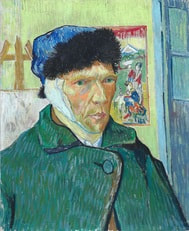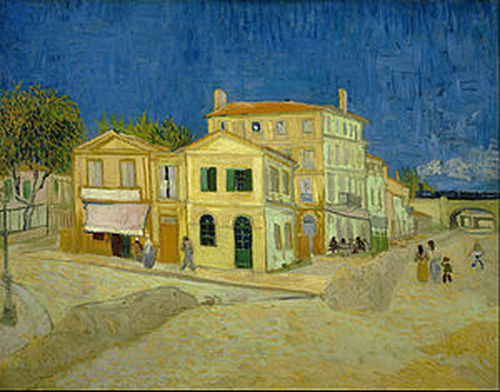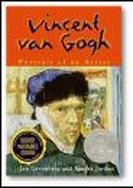 Self-portrait with Bandaged Ear, 1889, with an easel and a Japanese print in the background. The artist collected these prints when he lived in Paris Self-portrait with Bandaged Ear, 1889, with an easel and a Japanese print in the background. The artist collected these prints when he lived in Paris Who was Vincent Van Gogh? Ask around and most people come up with the same answer. He was the famous artist who cut off his ear. What is the truth about Vincent Van Gogh? Was he a great painter because he led a life of extremes? Or was he a great painter despite his disordered life? Several years before his death, he began to experience seizures and blackouts during which he heard voices and behaved strangely. Are the pulsating spirals, undulating lines and dizzying stars of his late paintings what he saw when he was having an attack? Or are they the result of a style he developed painstakingly through years of hard work? In 1888, Vincent moved to Arles in the south of France. He planned to establish an artists’ commune where his friends could live together to create a new direction in painting. Vincent persuaded the artist Paul Gauguin, who was desperate for money, to move to Arles to help him. Vincent also was lonely. For two months Gauguin lived in the Yellow House Vincent had lovingly filled with paintings hoping to impress his friend. Gauguin bossed Vincent around and criticized his artwork. Eventually, when Gauguin sold a few paintings, he threatened to abandon Vincent. Finally, on Christmas Eve, after a quarrel at dinner, Gauguin stalked off into the streets. Vincent followed him. What happened next is unclear, but Vincent returned to the Yellow House alone and cut off his earlobe (not the whole ear) with a razor. Vincent couldn’t remember the details of this terrible night. But when he was discharged from the hospital a few weeks later, he went right back to work. There have been many theories about Vincent’s condition. The theory most generally accepted is that he suffered from epilepsy, a disease that could have caused his seizures and hallucinations and for which there was no medication. In Vincent’s case, another reason for his “attacks” might have been his habit of drinking absinthe, an alcoholic drink popular in 19th century France. It contains a strong nerve poison, now illegal in most countries. Today many popular performers advertise how dangerous and extreme their lives are by writing shocking lyrics and acted outrageously on stage. They are mimicking the lives of artists such as Van Gogh. But he was not advertising or pretending. He just wanted to be useful—to make art that would last. His glorious paintings are the result of his discipline and dedication, despite the turmoil of his life.  Vincent Van Gogh, The Yellow House, 1888, oil on canvas, Van Gogh Museum, Amsterdam. This is the house at 2 Place Lamartine, Arles, France, where, on May 1, 1888, Vincent van Gogh rented four rooms and where Paul Gauguin lived for nine weeks from late October, 1888. The left wing housed a grocery (French: Comestibles, inscribed on the signboard over the marque). Van Gogh indicated that the restaurant, where he used to have his meals, was in the building painted pink close to the left edge of the painting.  If you are interested in finding out more about Vincent Van Gogh, Jan Greenberg and Sandra Jordan have written an award-winning book on the subject. Click here for more information.
0 Comments
Leave a Reply. |
Check out our new podcasts in the iTunes Store and on KidLit Radio.
|




 RSS Feed
RSS Feed
